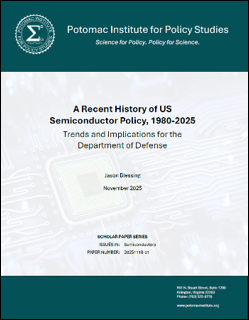
- Jason Blessing
A Recent History of US Semiconductor Policy, 1980-2025
- Jason Blessing
There is no single national policy for semiconductors. However, a variety of legislative and executive branch efforts have shaped how the US government and the Department of Defense (DoD) approach semiconductors. US policies related to semiconductors, particularly over the last five years, have prioritized national competitiveness with measures to invest in a secure supply chain, ensure trusted access, increase domestic manufacturing, and spur research and development (R&D). The CHIPS and Science Act of 2022 represents the largest recent investment in domestic semiconductors, with $52.7 billion authorized to bolster US-based manufacturing, workforce development, and R&D. National policies like the CHIPS and Science Act and evolving market dynamics have been important framing conditions for the development of DoD semiconductors policy.
KEY POINTS
- There is no single US national policy for semiconductors. Instead, a variety of legislative and executive branch efforts have targeted research and development (R&D), acquisition, sustainment, and broader national competitiveness in semiconductors.
- The Department of Defense (DoD) has been proactive in funding semiconductor R&D but reactive in formulating policy to regulate semiconductor access, supply, and use.
- DoD policy has transitioned from treating semiconductors as an R&D issue to acknowledging that semiconductors are also an acquisitions and sustainment issue.
- DoD policies to ensure trusted semiconductors continue to have gaps between intent and implementation.
- DoD policy remains unprepared for future shocks to the semiconductor market.


